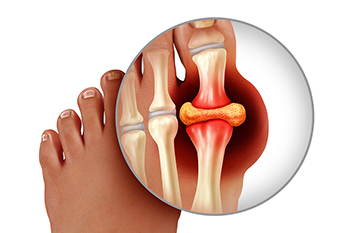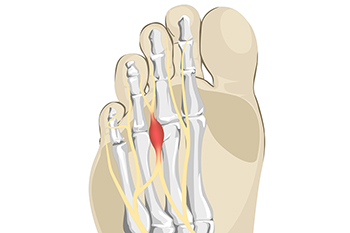Connect With Us
Blog
Items filtered by date: September 2021
Painful, Persistent Plantar Warts
Warts are growths on the skin caused by the human papillomavirus (HPV). They can occur in various areas of the body and are spread through direct contact or indirectly through contact with a surface or object that has previously been in contact with a wart. Plantar warts are flat, hard, and rough growths that develop on the bottom surface (plantar) of the foot. They are brown or gray, with tiny black dots in the center, which are actually blood vessels that nourish the wart with oxygen and nutrients. Plantar warts can be individual or grow in clusters. They are typically tender and can be quite painful while walking and standing. While they may go away on their own, it can take years to completely rid yourself of them. If you have one or more plantar warts that are causing you discomfort, contact a podiatrist who has a variety of treatment options to remove the wart.
Plantar warts can be very uncomfortable. If you need your feet checked, contact Tanisha Richmond, DPM from Richmond Foot & Ankle, LLC. Our doctor will assist you with all of your foot and ankle needs.
About Plantar Warts
Plantar warts are the result of HPV, or human papillomavirus, getting into open wounds on the feet. They are mostly found on the heels or balls of the feet.
While plantar warts are generally harmless, those experiencing excessive pain or those suffering from diabetes or a compromised immune system require immediate medical care. Plantar warts are easily diagnosed, usually through scraping off a bit of rough skin or by getting a biopsy.
Symptoms
- Lesions on the bottom of your feet, usually rough and grainy
- Hard or thick callused spots
- Wart seeds, which are small clotted blood vessels that look like little black spots
- Pain, discomfort, or tenderness of your feet when walking or standing
Treatment
- Freezing
- Electric tool removal
- Laser Treatment
- Topical Creams (prescription only)
- Over-the-counter medications
To help prevent developing plantar warts, avoid walking barefoot over abrasive surfaces that can cause cuts or wounds for HPV to get into. Avoiding direct contact with other warts, as well as not picking or rubbing existing warts, can help prevent the further spread of plantar warts. However, if you think you have developed plantar warts, speak to your podiatrist. He or she can diagnose the warts on your feet and recommend the appropriate treatment options.
If you have any questions please feel free to contact our office located in Dayton, OH . We offer the newest diagnostic and treatment technologies for all your foot and ankle needs.
Understanding Gout
Gout is a type of inflammatory arthritis where excess amounts of uric acid causes hard crystals to form in the joints—most commonly affected is the big toe joint. The body’s inability to flush uric acid may be caused by kidney disease, diabetes, high blood pressure, obesity, certain medications, consuming foods and beverages that are high in purines, and a family history of gout. The pain felt by gout can often be acute, and may be accompanied by a burning sensation, swelling, and severe tenderness in the big toe. A podiatrist can diagnose gout through an examination, blood tests and analysis of joint fluid, and create a treatment plan based on their findings and the severity of the condition in the patient.
Gout is a foot condition that requires certain treatment and care. If you are seeking treatment, contact Tanisha Richmond, DPM from Richmond Foot & Ankle, LLC. Our doctor will treat your foot and ankle needs.
What Is Gout?
Gout is a type of arthritis caused by a buildup of uric acid in the bloodstream. It often develops in the foot, especially the big toe area, although it can manifest in other parts of the body as well. Gout can make walking and standing very painful and is especially common in diabetics and the obese.
People typically get gout because of a poor diet. Genetic predisposition is also a factor. The children of parents who have had gout frequently have a chance of developing it themselves.
Gout can easily be identified by redness and inflammation of the big toe and the surrounding areas of the foot. Other symptoms include extreme fatigue, joint pain, and running high fevers. Sometimes corticosteroid drugs can be prescribed to treat gout, but the best way to combat this disease is to get more exercise and eat a better diet.
If you have any questions please feel free to contact our office located in Dayton, OH . We offer the newest diagnostic and treatment technologies for all your foot and ankle needs.
Wounds That Don't Heal Need to Be Checked
Morton’s Neuroma and the Invisible Pebble
Morton’s neuroma is a condition where a nerve located between the toes becomes damaged and swollen. This usually occurs due to injuries from playing sports or wearing ill-fitting shoes. Morton’s neuromas are most common among women, people between the ages of 40 and 60, and those who have foot deformities like bunions and hammertoes. Common symptoms include sharp, stabbing, shooting, or burning pain in the ball of the foot, and tingling and numbness. The hallmark symptom of this condition, however, is the strange sensation that you are walking on a pebble in your shoe, even though there is no pebble there. If you are experiencing the symptoms of Morton’s neuroma, consult with a podiatrist, who can find the right treatment for you.
Morton’s neuroma is a very uncomfortable condition to live with. If you think you have Morton’s neuroma, contact Tanisha Richmond, DPM of Richmond Foot & Ankle, LLC. Our doctor will attend to all of your foot care needs and answer any of your related questions.
Morton’s Neuroma
Morton's neuroma is a painful foot condition that commonly affects the areas between the second and third or third and fourth toe, although other areas of the foot are also susceptible. Morton’s neuroma is caused by an inflamed nerve in the foot that is being squeezed and aggravated by surrounding bones.
What Increases the Chances of Having Morton’s Neuroma?
- Ill-fitting high heels or shoes that add pressure to the toe or foot
- Jogging, running or any sport that involves constant impact to the foot
- Flat feet, bunions, and any other foot deformities
Morton’s neuroma is a very treatable condition. Orthotics and shoe inserts can often be used to alleviate the pain on the forefront of the feet. In more severe cases, corticosteroids can also be prescribed. In order to figure out the best treatment for your neuroma, it’s recommended to seek the care of a podiatrist who can diagnose your condition and provide different treatment options.
If you have any questions, please feel free to contact our office located in Dayton, OH . We offer the newest diagnostic and treatment technologies for all your foot care needs.
What Can Cause Blisters?
 Blisters are a common occurrence among runners. They appear as small bubbles that are filled with liquid, and are the body’s natural defense in protecting raw skin. When new skin has formed, the blister will gradually drain, and is no longer needed for protection. Blisters can wreak havoc on a running regime, despite the fact they are not considered to be a serious foot injury. They often develop as a result of excess friction, which can be caused by wearing shoes and socks that do not fit correctly. Relief for existing blisters can consist of placing a dry bandage over the affected area, and it may help to wear socks that are made from materials that can absorb sweat. If you develop blisters on your feet frequently, it is suggested that you are under the care of a podiatrist who can treat infected blisters and recommend effective prevention methods.
Blisters are a common occurrence among runners. They appear as small bubbles that are filled with liquid, and are the body’s natural defense in protecting raw skin. When new skin has formed, the blister will gradually drain, and is no longer needed for protection. Blisters can wreak havoc on a running regime, despite the fact they are not considered to be a serious foot injury. They often develop as a result of excess friction, which can be caused by wearing shoes and socks that do not fit correctly. Relief for existing blisters can consist of placing a dry bandage over the affected area, and it may help to wear socks that are made from materials that can absorb sweat. If you develop blisters on your feet frequently, it is suggested that you are under the care of a podiatrist who can treat infected blisters and recommend effective prevention methods.
Blisters are prone to making everyday activities extremely uncomfortable. If your feet are hurting, contact Tanisha Richmond, DPM of Richmond Foot & Ankle, LLC. Our doctor can provide the care you need to keep you pain-free and on your feet.
Foot Blisters
Foot blisters develop as a result of constantly wearing tight or ill-fitting footwear. This happens due to the constant rubbing from the shoe, which can often lead to pain.
What Are Foot Blisters?
A foot blister is a small fluid-filled pocket that forms on the upper-most layer of the skin. Blisters are filled with clear fluid and can lead to blood drainage or pus if the area becomes infected.
How Do Blisters Form?
Blisters on the feet are often the result of constant friction of skin and material, usually by shoe rubbing. Walking in sandals, boots, or shoes that don’t fit properly for long periods of time can result in a blister. Having consistent foot moisture and humidity can easily lead to blister formation.
Prevention & Treatment
It is important to properly care for the affected area in order to prevent infection and ease the pain. Do not lance the blister and use a Band-Aid to provide pain relief. Also, be sure to keep your feet dry and wear proper fitting shoes. If you see blood or pus in a blister, seek assistance from a podiatrist.
If you have any questions, please feel free to contact our office located in Dayton, OH . We offer the newest diagnostic and treatment technologies for all your foot care needs.
Plantar Warts Can Be Treated!
Blog Archives
- April 2025
- March 2025
- February 2025
- January 2025
- December 2024
- November 2024
- October 2024
- September 2024
- August 2024
- July 2024
- June 2024
- May 2024
- April 2024
- March 2024
- February 2024
- January 2024
- December 2023
- November 2023
- October 2023
- September 2023
- August 2023
- July 2023
- June 2023
- May 2023
- April 2023
- March 2023
- February 2023
- January 2023
- December 2022
- November 2022
- October 2022
- September 2022
- August 2022
- July 2022
- June 2022
- May 2022
- April 2022
- March 2022
- February 2022
- January 2022
- December 2021
- November 2021
- October 2021
- September 2021
- August 2021
- July 2021
- June 2021
- May 2021
- April 2021
- March 2021
- February 2021
- January 2021
- December 2020
- November 2020
- October 2020
- September 2020
- August 2020
- July 2020
- June 2020
- May 2020
- April 2020
- March 2020
- February 2020
- January 2020
- December 2019
- November 2019
- October 2019
- September 2019
- August 2019
- July 2019
- June 2019
- May 2019
- April 2019
- March 2019
- February 2019
- January 2019
- December 2018
- November 2018




